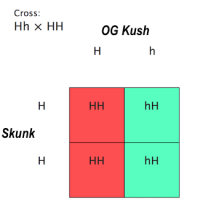Is it a bad idea to use feminized plants for breeding?
At some point in forum perusal, you will likely encounter some form of this question: “
Can you use a feminized plant for breeding?” Answers will generally fall along yes or no, but lack a more full-throated explanation as to why the poster feels this is a good/bad practice.
Answers in the affirmative are usually guided by experience and take the form, “I have a feminized plant that is more stable than most reg plants. She doesn’t put out any hermie progeny.” While others take an opposite stance (
can be guided by experience, but many times just repeating an assumption read from someone else), “No way! Feminized plants are inherently bad stock and will lead to hermie prone progeny.”
I will balance my stance by playing each side of this question and say that both of these sides are correct. While it seems counterintuitive to say both apparently contradictory answers are the case, I’ll illustrate using Punnett Squares.
Many times, traits that are considered bad can be recessive (
think small letter allele), but can be “hidden” when paired with a dominant allele (
think uppercase allele). Much like disease in humans, both partners must be carriers of specific genes in order for the disease to express in progeny. Statistically speaking, the chances of any two random partners ensure the appearance of these genetic disorders is relatively low.
By selfing, or breeding a plant to itself, you are guaranteeing that whatever undesirable recessive traits lurk in the gene pool will necessarily double down and increase the chance of its expression in the progeny. What was before a possibility, has now been made a certainty.
Let’s see an example:
We have an OG Kush female we kept from a pack of fems. This OG did not express any intersex traits while growing, but some of her sisters did. We feel good about this plant because the phenotype did not show any hermie trait, but let’s remember we cannot see the genotype.
We’ll use
H(
no hermie) and
h(
hermie) to describe the alleles that code for stability. Since this pheno does not express the hermie trait, but the sisters did, we can assume our chosen OG Kush has the genotype (
Hh).
Let’s see what happens to the progeny when we self this OG Kush

We see that 25% of the resulting S1 plants are hermie prone (
hh). Now we can appreciate the importance of genotype and its role in subsequent generations. Even though the chosen OG Kush
phenotype was as stable as could be, the presence of the recessive hermie trait allele (
h) means you’ll be dealing with some presence of hermie prone plants down the line.
Now does this mean feminized seeds are inherently bad stock? Let’s keep in mind that the phenomenon just described would also be true of masculinized seeds as the true culprit here is simply the fact that by breeding the exact same genotype to itself, we are guaranteeing a doubling down of the recessive traits. If only 10% of a population is a carrier for a disease, this means that only couples that happen to both be carriers will produce affected children. By selfing, we now went from 10% to 100% and the rate of recessive expression has just increased.
So my answer to the question would be Yes and No.
Yes, selfing can produce a higher rate of issues in progeny, but only because of the logical conclusion that you’ve ensured recessive alleles are present for both contributing parents.
No, if you notice from the Punnett Square, we’ve also produced true-breeding stable (
HH) plants. So it’s not that all progeny are forever cursed with the hermie trait, you can also create very stable plants.
You could use this OG Kush for a regular seed-breeding program and “cleanout” the hermie trait phenotype assuming your male is true-breeding.
Let’s see our OG Kush fem plant (
Hh) crossed to a true-breeding Skunk (
HH)

Now we can see that all of the progeny have a stable no hermie
phenotype. It would be understandable how you could then come to the conclusion that breeding regular seeds is superior to selfing.
An interesting point to consider: While all of the phenos are hermie-free, some genotypes here (
Hh) still include the ingredients for hermie-prone plants appearing again in later generations. Navigating proper selection is the hallmark of a solid breeding program. This should also hint toward why F2 populations can be so variable coming from otherwise "stable" F1.
Only limiting ourselves to phenotype (
can’t see genotypes) it now makes sense why there are so many seemingly contradictory opinions on this subject.
Ultimately, the answer to this question is, “It depends.” This may not be totally satisfactory, but using the Punnett Squares, we can gain a better appreciation for the nuances involved with this concept.
what if you wrapped it like a burrito in plastic wrap lol
what if you wrapped it like a burrito in plastic wrap lol

